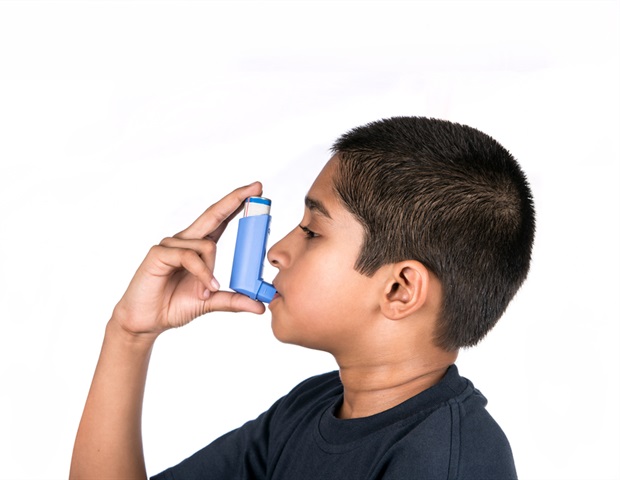
Researchers on the College of Pittsburgh have developed a nasal swab check for teenagers that diagnoses particular bronchial asthma subtype, or endotype. This non-invasive strategy might assist clinicians prescribe medicines extra exactly and pave the best way for analysis towards higher remedies for lesser-studied bronchial asthma sorts, which have been tough to diagnose precisely till now.
Printed right this moment in JAMA, the findings are based mostly on knowledge from three unbiased U.S.-based research that targeted on Puerto Rican and African American youths, who’ve increased charges of bronchial asthma and usually tend to die from the illness than their non-Hispanic white counterparts.
Bronchial asthma is the most typical continual illness of childhood, and it disproportionately impacts Black and Puerto Rican youngsters, so it is important that we develop new therapies to raised deal with these younger sufferers. As a result of bronchial asthma is a extremely variable illness with totally different endotypes, that are pushed by totally different immune cells and reply in another way to remedies, step one towards higher therapies is correct prognosis of endotype.”
Juan Celedón, M.D., Dr.P.H., senior writer, professor of pediatrics at Pitt and chief of pulmonary drugs at UPMC Kids’s Hospital of Pittsburgh
Historically, bronchial asthma has been categorised into endotypes often known as T2-high or T2-low based mostly on the quantity of T helper 2 irritation current. Extra not too long ago, T2-low has been cut up into two endotypes: T17-high, which has much less T helper 2 irritation and extra T helper 17 irritation, and low-low, which has low ranges of each sorts of irritation.
Exact prognosis of endotype normally entails genetic evaluation of a lung tissue pattern taken by a process known as a bronchoscopy, which is completed underneath common anesthesia. For kids, particularly these with milder illness, it is not possible or moral to carry out this invasive process, so clinicians have needed to depend on imperfect instruments, together with immune markers within the blood, lung operate and whether or not or not they’ve allergic reactions.
“These assessments permit us to presume whether or not a toddler has T2-high illness or not,” mentioned Celedón. “However they aren’t 100% correct, they usually can not inform us whether or not a toddler has T17-high or low-low illness. There isn’t any medical marker for these two subtypes. This hole motivated us to develop higher approaches to enhance the accuracy of bronchial asthma endotype prognosis.”
Celedón and his staff, together with first authors Molin Yue, M.S., a Pitt graduate pupil, and Kristina Gaietto, M.D., M.P.H., teacher of pediatrics at Pitt, collected nasal samples from 459 youth throughout three totally different research. Then they analyzed the expression of eight T2 and T17 signature genes.
As anticipated, evaluation of nasal swab samples revealed a affected person’s endotype. Throughout research, 23% to 29% of contributors had T2 excessive, 35% to 47% had T17-high and 30% to 38% had low-low endotype.
For treating extreme T2-high bronchial asthma, there’s a highly effective new class of medicine known as biologics, which goal the immune cells that drive illness. Nonetheless, no out there bronchial asthma biologics instantly goal T17-high and low-low endotypes.
“Now we have higher remedies for T2-high illness, partly, as a result of higher markers have propelled analysis on this endotype,” mentioned Celedón. “However now that we’ve a easy nasal swab check to detect different endotypes, we will begin to transfer the needle on creating biologics for T17-high and low-low illness.”
This fast check for bronchial asthma endotype might additionally assist push ahead different areas of bronchial asthma analysis.
“One of many million-dollar questions in bronchial asthma is why some children worsen as they enter puberty, some keep the identical and others get higher. Earlier than puberty, bronchial asthma is extra frequent in boys, however the incidence of bronchial asthma goes up in females in maturity,” mentioned Celedón. “Is that this associated to endotype? Does endotype change over time or in response to remedies? We do not know. However now that we will simply measure endotype, we will begin to reply these questions.”
Gustavo Matute-Bello, M.D., performing director of the Division of Lung Ailments on the Nationwide Coronary heart, Lung, and Blood Institute, a part of the Nationwide Institutes of Well being (NIH) added, “Having instruments to check which organic pathways have a serious function in bronchial asthma in youngsters, particularly those that have a disproportionate burden of illness, could assist obtain our aim of enhancing bronchial asthma outcomes. This analysis has the potential to pave the best way for extra customized remedies, significantly in minority communities. Extra research are wanted.”
Different authors on the research have been Yueh Ying Han, Ph.D., Franziska J. Rosser, M.D., M.P.H., Zhongli Xu, Christopher Qoyawayma, B.S.E., Erick Forno, M.D., M.P.H., and Wei Chen, Ph.D., all of Pitt and UPMC; and Edna Acosta-Perez, Ph.D., and Glorisa Canino, Ph.D., each of the College of Puerto Rico.
This analysis was supported by the NIH (HL079966, HL117191, HL150431, HL119952, UL1TR001857, HL129949, K08 HL159333 and HL149693).
This content material is solely the accountability of the authors and doesn’t essentially characterize the official views of the NIH.
Supply:
Journal reference:
Yue, M., et al. (2025) Transcriptomic Profiles in Nasal Epithelium and Bronchial asthma Endotypes in Youth. JAMA. doi.org/10.1001/jama.2024.22684.